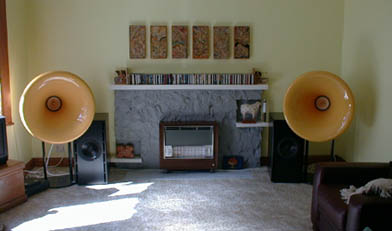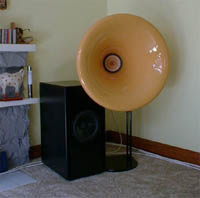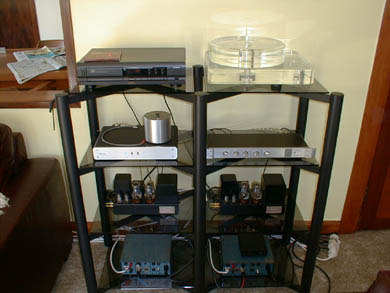Russell Craig, New Sealand
I've owned the Oris 150s and Onken-based woofers of Bert's design for several months now. Like everybody else who has posted notes on their Oris experiences on Bert's site, I have to say that I am absolutely delighted with the results I am obtaining, and do not foresee changing them for a long time - perhaps forever.
Finding the Oris has been part of a quest that began through wanting to use low powered SET's, having become addicted to their sound while in the USA in 1995 (I've still to get the SETs!). Of course, if I wanted to use SET's I was going to have to use some pretty high efficiency loudspeakers - higher even than my cherished 15 inch Tannoys in Tannoy's largest bass reflex cabinet. And so the search began.
Finding the right replacements was going to take some doing, because I was not prepared to give up the musicality and great tone of the Tannoy dual concentric design. My research began to bear fruit when I found the Triode Guild website of the late Harvey Rosenberg a.k.a Dr Gizmo. Through him I was inspired to persist in pursuing my goal of using highly refined SET's in conjunction with high efficiency loudspeakers and active crossovers.

But this wasn't the only inspiration Gizmo gave me - he also convinced me that I could roll my sleeves up and build this stuff myself. And, finally, he wrote a few pieces about Lowther drivers. He talked about "ascending to micro power", and "the one-way way" (not with active woofers mind you!), the tonal righteousness of alnico magnets, and the frustrating colourations of the Lowther driver.
Bearing this last point in mind, I started to learn a lot more about Lowthers and found Bert's site. I was pretty impressed by what I saw, and when next in Sydney on business I took the opportunity of visiting Jurek Nowak (Bert's Australian distributor) for a listen to his 150's with PM4A's and Onkens.At the same time that I ordered the Oris, I ordered a Reveille Active crossover kit from Ron Welborne - my first venture into DIY electronics.
So what have been the results so far? Two words: total satisfaction. Using the current system described below (except for the turntable which is still being assembled), this is the best sound I've ever heard - period. All those great qualities of Lowthers, horns AER cones, alnico etc. are all here in spades. Music is music - not hi-fi: it has scale, presence, timbral accuracy, coherence and astonishing transparency. The top end supports the assertion that the best tweeter is no tweeter at all, and the huge bandwidth of the drivers confirms that (almost) one way is the only way to go. Bert's Onken woofer design is up to the task of putting a solid, coherent and tuneful foundation in place for the overall sound in a way that integrates seamlessly at least to my ears - no plodding, overblown one note bass here! These things can rock the house when asked to. I think Ron Welborne's crossover makes a big contribution here.


Best of all, all types of music are equally well served: from large scale orchestral to intimate chamber works; from classical to jazz through hard-out rock and funk to folk, these speakers handle it all with a plomb. And did I mention how delicious female vocalists can sound, and how involving all those live albums suddenly are, and how it takes a while to get used to the absence of so many layers of distortion, and....
Actually I find it hard to single out aspects of the performance for special mention - these are special speakers that give a magic result. They also kick sand in the face of just about anything else I've ever heard. Perhaps, however, the most important thing for me is that I want to listen to more and more music, and find myself enjoying pretty much every recording somehow - and always for its musical, not audio, attributes. And here's the kicker - it's not just me who loves these speakers, its also my wife (who chose the color!) and everybody else who has heard them. The other thing that these speakers have done is give me a solid platform on which to build the rest of my system. I've got a number of projects on the go - a Teres turntable to get my 2500 LP's spinning, an AKSA kitset amp for the woofers; a phono preamp using DACT CT100/101 modules, transformer attenuators, and Welborne Labs power supplies; and finally that long awaited SET ( a two stage IT coupled 45 SET currently in the design stage).Then there are experiments to do with cabling, diffusors etc. And then, one day, a tube preamp. And I know that the Oris will just let the changes shine through across time.
Some final thoughts about the Oris experience would have to include the experience I've had in putting this system together so far - Bert, Jurek, Ron, Chris Brady of Teres, and Hugh Dean of AKSA fame have been awesomely helpful and patient with a newcomer to the hands-on side of audio. Also, SET nuts take note: QUAD II's sound pretty awesome on these horns - way better than you might believe a 50 year old PP amplifier has a right to!
They say that sometimes the journey is more important than the destination. The journey I'm on with the Oris
is going to go on for some time I think. And I can recommend it most highly.................
Current [future] system:
- CD Player: Phillips CD502 (old, cheap, multibit player) [something]
- Turntable/Tonearm/Cartridge: Teres (kitset)/ETII/Audio Technica AT160ML; Shinon Red Boron
- Preamplifier: Threshold FET9 [DACT CT100 phono/CT101 line w. transformer attenuators]
- HF amplifiers: Quad II (restored) w. NOS GEC KT66's [homemade 417A/45 IT coupled SET]
- LF amplifiers: homebrew 50 watt mosfet monoblocks [AKSA 100 watt SS (kitset)]
- Crossover: Welborne Labs Reveille Active Crossover (kitset)
- Mains supply: dedicated 20A line with separate earth. No conditioning.